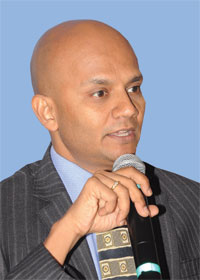
 M Vennimalai
M Vennimalai
CEO, Aavanor Systems
How do you see the advancement in the field of Hospital Management Information Systems in the recent years?

IT usage by hospitals has rapidly matured over the recent years, Hospital Information Systems (HIS) is being used in far deeper ways and we seem to have moved on from the uni-faceted – billing is key approach. With this upgradation of user requirements, we see an increase in demand for systems that help improve effectiveness of operations.
Surprisingly NABH has helped hospitals focus on effective management addressing all key aspects of running a hospital, and this is motivating healthcare providers into seeking holistic solutions.
Please provide us with a brief about your products.

Over the last 12 years, our product has evolved into a complete suite, which automates almost every department in the hospital. Starting from Q…less Money, which enables remote registration using mobile phones to No Entry Store, a completely automated store and pharmacy department, where almost no data entry is required. From using eBook EMR to practically eliminating training for doctors and nurses, to providing a Fully Loaded HIS that comes with all possible clinical templates, lab tests, medicines, charge heads and packages. The Hospaa3 suite of healthcare solutions automates all the departments of large to medium healthcare organisations. Our multi-tenanted cloud based offering is a robust Java based product that has been refined over the years and can get a hospital automated in less than 30 days.
| A good HIS can positively impact almost every trouble spot in the healthcare facility from medication errors, to wait time management, inaccurate billing and waste reduction, says M Vennimalai in an interaction with eHealth |
| The biggest challenges for hospitals is to come up with a clear long term roadmap in terms of technology and scope of IT usage, without falling into the temptation of doing something in this budget year. |
What is the market size of the HIS industry in India?A Can you tell us the cost of installation?
The market is highly stratified. We see it being split into very large governmental market where multiple hospitals are networked and projects are in the range of a few hundred crore of rupees each. Chain hospitals with each facility having 100 plus beds are being automated through use of multi-tenanted web applications or cloud applications, at the cost of around ` 50,00,000 to ` 1 crore. Smaller hospitals with less than 100 beds are being automated at around ` 25 lakh.
The cost is entirely dependent on the scope of automation. Many small organisations are investing heavily in IT systems as they see them as being a vital tool for achieving success in the high growth market.
How can IT create its space in hospitals? What are the challenges faced by the solution providers?
There are still a number of offerings which push outdated concepts and technologies without a clear roadmap for future upgradation. The number of client server offerings and independent department solutions that are still being adopted is alarming.
I think the biggest challenge for hospitals is to come up with a clear long term roadmap in terms of technology and scope of IT usage, without falling into the temptation of doing something in this budget year. The challenge for solution providers is the same, we need to engage healthcare providers and establish a clear vision for IT deployment. The obsession about closing the deal must end.
I must also state that hospitals must look beyond their preference for established technologies and providers, and seriously uate the possibilities of new offerings. We are in the stage where a simple but critical advancement in the IT offering can bring RoI to the entire project within a 2 year span.
How far do you think HIS and HMIS has increased efficiency and output in the hospitals?
Sometimes an external push is required to get us out of our comfort zones. This is the role of HIS and HMIS. It provides the impetus to bring further advancements in the healthcare sector. It must be said that we owe a great deal to the Obama government in the US, which bit the bullet and firmly moved healthcare into the digital age. This decision was made with the objective of providing patients with better care, which surprisingly enough was long overlooked as a key concern. There has not been a single physician who would go back to paper after using an effective EMR nor a hospital that would go back to paper after using an integrated IT system. This is because the benefits are clear and visible at every layer.
What are the key challenges in the adoption of HIS/HMIS?
The biggest challenge is to envision the ranges of services that a good HIS can provide. There are many instances of industry dismissing the latest developments as fads. This leads to loss of time and we are left playing catch up. A good HIS can positively impact almost every trouble spot in the healthcare facility from medication errors, to wait time management, to inaccurate billing and to waste reduction. I remember meeting a paper industry professional who was in shock after a visit to a paper manufacturing facility in Finland that employed four engineers to run a plant of the same size that his organisation used to run with a staff of 377 staff. Proper and effective automation had achieved such high level of efficiency that only four people could do the job of 377.
IT can definitely make huge contributions in addressing uncharted territory such as traffic congestion. By connecting doctors and patients to the facility in a remote yet satisfactory manner, we can bring resolution to many health realated issues. Anyone who has purchased HD TV recently will be amazed by the fantastic quality of beamed digital images and this will soon become a part of everyday commerce and indeed healthcare.
So in my view the biggest challenge facing the adoption of HIS in India today is our penchant to Think Small rather than Think Big. But this is rapidly changing and just last week I was visiting Sanjiban, a facility in a rather remote village in West Bengal, which has the most amazing plans to setup a modern, scientific and comprehensive healthcare delivery system. Their growth has been explosive and they plan to fully utilise IT to serve their patients- be it communicating directly and extensively with the patient mobile phone or providing a paperless setup in the hospital that can be accessed from anywhere in India.
What kind of HIS/HMIS solutions can be expect in future?
Lot of innovations are expected. Many companies and healthcare entities are working to make all kinds of advancements possible in the HIS/HMIS space.
We believe that successful HIS offerings in the future will bring about an Apple type of revolution. There can be disruption of the existing setup as new kind of products come into being. All the key stakeholders in the medical space including doctors, nurses, allied services staff, administrators and also the patients – are going to benefit from the revolution.//
Be a part of Elets Collaborative Initiatives. Join Us for Upcoming Events and explore business opportunities. Like us on Facebook , connect with us on LinkedIn and follow us on Twitter , Instagram.











